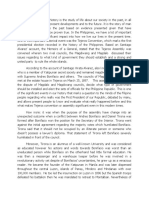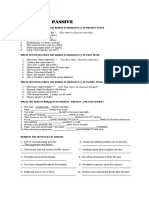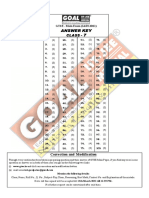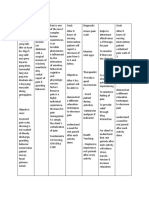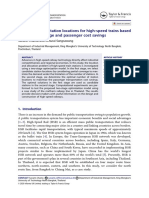Professional Documents
Culture Documents
Meaning and Relevance of History
Meaning and Relevance of History
Uploaded by
Al-waleed Julkanain0 ratings0% found this document useful (0 votes)
217 views2 pagesThis document discusses the meaning and relevance of history, sources of history, types of sources, criticism of sources, and repositories and kinds of primary sources. History is the documented record of human society and achievements from the beginning of written records to present. Sources are the origin of information and data in historical study and can be primary sources like eyewitness accounts or secondary sources like textbooks. Both external and internal criticism are used to establish the authenticity and accuracy of sources. Primary sources are housed in various repositories like national archives and museums. Common primary sources include artifacts, laws, accounts, maps, and personal letters.
Original Description:
Original Title
History
Copyright
© © All Rights Reserved
Available Formats
DOCX, PDF, TXT or read online from Scribd
Share this document
Did you find this document useful?
Is this content inappropriate?
Report this DocumentThis document discusses the meaning and relevance of history, sources of history, types of sources, criticism of sources, and repositories and kinds of primary sources. History is the documented record of human society and achievements from the beginning of written records to present. Sources are the origin of information and data in historical study and can be primary sources like eyewitness accounts or secondary sources like textbooks. Both external and internal criticism are used to establish the authenticity and accuracy of sources. Primary sources are housed in various repositories like national archives and museums. Common primary sources include artifacts, laws, accounts, maps, and personal letters.
Copyright:
© All Rights Reserved
Available Formats
Download as DOCX, PDF, TXT or read online from Scribd
Download as docx, pdf, or txt
0 ratings0% found this document useful (0 votes)
217 views2 pagesMeaning and Relevance of History
Meaning and Relevance of History
Uploaded by
Al-waleed JulkanainThis document discusses the meaning and relevance of history, sources of history, types of sources, criticism of sources, and repositories and kinds of primary sources. History is the documented record of human society and achievements from the beginning of written records to present. Sources are the origin of information and data in historical study and can be primary sources like eyewitness accounts or secondary sources like textbooks. Both external and internal criticism are used to establish the authenticity and accuracy of sources. Primary sources are housed in various repositories like national archives and museums. Common primary sources include artifacts, laws, accounts, maps, and personal letters.
Copyright:
© All Rights Reserved
Available Formats
Download as DOCX, PDF, TXT or read online from Scribd
Download as docx, pdf, or txt
You are on page 1of 2
Meaning and Relevance of History In the study of Philippine history, sources are
called batis which also means stream or a
a documented record of man and his society.
spring. A batis therefore is the spring speech,
field of study: study of man and his
achievements from the beginning of written Types of Sources
records to the present time (Gray, 1956 in De
Primary sources are considered as the lifeblood
Viana, 2015)
of history.
everything that has happened or occurred from
De Viana (2015): directly talks about the subject
the beginning of the time to the last instance.
matter. Accounts of people who are direct
record: a documented history of man and his
participants or eyewitness to an event are also
society.
primary sources.
literature: an effective presentation of the
Examples: minutes of meeting, diaries and
unfolding of events.
journals, autobiographies, speeches, receipts,
Abbot in De Viana (2015): the historian has the
essays written by a person expressing his views,
ability to depict the unravelling of fateful events
laws, letters of instructions, decrees, letters,
and to portray the rise and deterioration of
eyewitnesses accounts, official reports,
character of events, ranking it with novels and
newsletter articles reporting directly about the
epic poetry.
event, editorials or books containing direct
De Viana (2015): record of events: shows the quotation of events.
evolution of man and his society and from the
age of barbarism to what he is today.
Secondary sources are documents or works
students of history: record of the past showing made by individuals who are not directly
his development and improvement throughout involved to the events or made by people who
the ages and how he met his various challenges obtained the information from somebody else or
through time. from primary sources.
is not merely a chronology, i.e., a list of events Examples: textbooks, encyclopedia entries,
as they happen, but this should show a pattern newspapers, accounts of a meeting, magazine
on how man and his society has evolved from articles about a subject or teachers' reports on
the primitive form to the present; showing his student behavior as reported by school
ability to cope with obstacles and challenges that counselors.
he himself or nature has placed throughout his
existence. External and Internal Criticism
Sources of History Historical sources exist independent of the
research study since they were not written or
Sources are very important, in the study of developed for use of research. Thus, while they
history. They are the originators of information serve their purpose well for which they are
and data. created, they may not solely serve the
Abott places sources with documents, written researchers' purpose.
materials that says something about historical All sources of historical data must be subjected
events. to rigorous scientific analysis to determine both
Documents can be letters, receipts, copies of their authenticity and their accuracy.
eyewitness accounts, narrations, or books. These Furthermore, historical data are subjected to
are some of the sources and are NOT the only rigorous scientific analysis through external and
sources of history. internal criticism (Gottchalk, 1969).
not written: such as relics, fossils, remains, and
memorabilia. External criticism is the establishment of
alive: living eyewitnesses. When the researcher authenticity.
uses them in his research, they are always
known as respondents or informants.
Its purpose to ensure that, the documents are not 9. Personal Account
mere forgeries or inventions. 10. NEWSPAPERS
If the researcher is dealing with a problem for 11. Magazines
which source are relatively old, and for which 12. Legislative Journals
authenticity is not necessarily a given, there are 13. Court Records
a number of scientific techniques available such 14. Speeches
as the physical and chemical tests. 15. Personal Letters
16. On line databases
Internal criticism, on the other hand, is the 17. Blogs
establishment of accuracy. Its purpose is to 18. Documentary Films
evaluate the accuracy and the worth of the data. 19. Recorded Interviews
In determining the accuracy of the data, four
factors are to be considered, namely: (a) author's
knowledge and competence, (b) time delay, (c)
motives and biases of the author, and (d)
consistency of the data. The verified facts were
then presented as objectively as possible, into a
narrative form following the stated framework
for interpretation and analysis.
The analysis involved in historical research data
was logical analysis rather than statistical
analysis.
Repositories of Primary Sources
1. National Archives of the Philippines
2. National Library of the Philippines
3. National Historical Commission of the
Philippines
4. National Museum of the Philippines
5. U.P. Main Library
6. ADMU Rizal Library
7. DLSU Library
8. UST Library
9. Library of Congress
10. National Archives and Records Administration
11. Archivo General de Indias
12. Archivo General de la Nacion
13. American Historical Collection
14. Lopez Memorial Museum
15. Ayala Museum
Kinds of Primary Sources
1. Human fossils
2. Artifacts
3. Royal Decrees& Laws
4. Official Reports
5. Chronicles
6. Friar accounts
7. Maps
8. Memoirs
You might also like
- TheoryDocument3 pagesTheoryCarl Medina100% (1)
- Uts Lesson 9Document6 pagesUts Lesson 9Genaro Jr. LimNo ratings yet
- Christopher PawlingDocument252 pagesChristopher PawlingSakshi Suman100% (1)
- Module 1 - History: Definition, Nature, Methodology and ImportanceDocument69 pagesModule 1 - History: Definition, Nature, Methodology and ImportanceJAMIE DUAYNo ratings yet
- 2020 - Communication and Globalization World EnglishesDocument18 pages2020 - Communication and Globalization World EnglishesAnn Beloved CrownedNo ratings yet
- Fili Pino ValuesDocument6 pagesFili Pino ValuesyenNo ratings yet
- Sulong KabataanDocument19 pagesSulong KabataanYancy Monroy UbandoNo ratings yet
- 2 Writing Test - Chapter 2 - The Global Economy - Quizlet SolutionDocument2 pages2 Writing Test - Chapter 2 - The Global Economy - Quizlet SolutionMia KulalNo ratings yet
- Benefits of MountaineeringDocument2 pagesBenefits of Mountaineeringhangyul yuriNo ratings yet
- GEEC104 Living in The IT Era Module I L1Document7 pagesGEEC104 Living in The IT Era Module I L1Glaiza MabantaNo ratings yet
- STS-1st ActivityDocument5 pagesSTS-1st ActivityMateo, Elijah Jonathan C.No ratings yet
- Educ 6Document4 pagesEduc 6Ailyn CataluñaNo ratings yet
- Lesson 8 - The Political SelfDocument19 pagesLesson 8 - The Political SelfJhoy DubloisNo ratings yet
- 001 PPT GEC102 Meaning of HistoryDocument11 pages001 PPT GEC102 Meaning of HistoryRESTY FERNANDEZNo ratings yet
- Political SelfDocument8 pagesPolitical SelfFRANC MELAN TANAY LANDONGNo ratings yet
- Effectiveness of Social Media Marketing and Customer Engagement of Hotels in Digos CityDocument13 pagesEffectiveness of Social Media Marketing and Customer Engagement of Hotels in Digos CityNathalie CapaNo ratings yet
- Mobile Games and Academic Performance of University StudentsDocument7 pagesMobile Games and Academic Performance of University StudentsMarianita Jane P. BatinNo ratings yet
- THC1101 Module 1 Topics 1 and 2Document11 pagesTHC1101 Module 1 Topics 1 and 2YuGenNo ratings yet
- Chapter 3 - A World of RegionsDocument5 pagesChapter 3 - A World of RegionsJoanah Tayamen100% (2)
- Module 3Document5 pagesModule 3Kimberly Shine BlaseNo ratings yet
- Child Cluster 1 & 2Document4 pagesChild Cluster 1 & 2Czad Fered GilhangNo ratings yet
- GE Soc Sci 2 - Readings in Philippine History Lecture 1 - Introduction To The Study of Philippine HistoryDocument23 pagesGE Soc Sci 2 - Readings in Philippine History Lecture 1 - Introduction To The Study of Philippine Historyno veNo ratings yet
- Business Ethics and Social ResponsibilityDocument4 pagesBusiness Ethics and Social ResponsibilityVanassaCanlasNo ratings yet
- Assignment PurposiveDocument11 pagesAssignment PurposiveLonnie AsisNo ratings yet
- Art Appreciation Midterm ActivityDocument10 pagesArt Appreciation Midterm ActivityLaarnie Garcia Torreon IINo ratings yet
- Eapp 12-Q3-M12Document12 pagesEapp 12-Q3-M12Maya SweetNo ratings yet
- Volunteer Act of 2007 - Written ReportDocument6 pagesVolunteer Act of 2007 - Written ReportKent Lewis GornezNo ratings yet
- Topic 6 Stances On Economic Global IntegrationDocument43 pagesTopic 6 Stances On Economic Global IntegrationLady Edzelle Aliado100% (1)
- Ce4 A Case Study of Bridge Development Design Using Staad Software Between Brgy. San Rafael and Brgy. Sto. Niño Villareal SamarDocument25 pagesCe4 A Case Study of Bridge Development Design Using Staad Software Between Brgy. San Rafael and Brgy. Sto. Niño Villareal SamarJohn Michael BolocNo ratings yet
- Module 4 The Contemporary WorldDocument9 pagesModule 4 The Contemporary WorldMace Elizabeth KingNo ratings yet
- 3C CastilloDocument2 pages3C CastilloJillen ChanNo ratings yet
- College of Arts and Sciences (Cas) Central Philippines State University (Cpsu)Document123 pagesCollege of Arts and Sciences (Cas) Central Philippines State University (Cpsu)erica compao estimar0% (1)
- Purposive Com. Powerpoint 23Document15 pagesPurposive Com. Powerpoint 23Asnawi DicaliNo ratings yet
- Aug 14 - Who Is The FilipinoDocument35 pagesAug 14 - Who Is The FilipinoOphlynne PCNo ratings yet
- The Self in Western and Eastern ThoughtDocument23 pagesThe Self in Western and Eastern ThoughtWILFREDO GENERALESNo ratings yet
- Embracing The HumanitiesDocument10 pagesEmbracing The HumanitiesAna May Baniel100% (3)
- The Media & Information SourcesDocument13 pagesThe Media & Information Sourcesathenz_01No ratings yet
- sci and TechnologyDocument8 pagessci and TechnologyLaura JadeNo ratings yet
- FIN 102 Central Banking For Socio-Economic DevelopmentDocument9 pagesFIN 102 Central Banking For Socio-Economic DevelopmentDianara PagarNo ratings yet
- Chapter 1 - Ge102Document6 pagesChapter 1 - Ge102Euneel EscalaNo ratings yet
- RPH Prelim ReviewerDocument7 pagesRPH Prelim ReviewerPrincess Enrian Quintana PolinarNo ratings yet
- Mod 7 TEST OF HYPOTHESIS For BSADocument15 pagesMod 7 TEST OF HYPOTHESIS For BSABuboy FarmerNo ratings yet
- Chapter 1 - Origin and Nature of EntrepreneurshipDocument14 pagesChapter 1 - Origin and Nature of EntrepreneurshipArnel De Los SantosNo ratings yet
- STATUS OF INTERNET ACCESSIBILITY IN ACADEMIC PERFORMANCE OF STUDENTSreal CopymahalDocument26 pagesSTATUS OF INTERNET ACCESSIBILITY IN ACADEMIC PERFORMANCE OF STUDENTSreal CopymahalAlyza Rose Hernandez LunarNo ratings yet
- SS110 Position Paper (The Tejeros Convent)Document3 pagesSS110 Position Paper (The Tejeros Convent)Erika Noreen Dela RosaNo ratings yet
- DevMeth RRLDocument16 pagesDevMeth RRLacc_num2No ratings yet
- Module 2 in NSTP Part 2Document8 pagesModule 2 in NSTP Part 2Jecel LazarraNo ratings yet
- Pe 1 - Physical Fitness and Health: Physical Education Is A Component of The Curriculum. It Refers To The Four SubjectsDocument23 pagesPe 1 - Physical Fitness and Health: Physical Education Is A Component of The Curriculum. It Refers To The Four SubjectsBalonio Dexcie BilloNo ratings yet
- Relationship of Ethics With Other Phases of HumanDocument4 pagesRelationship of Ethics With Other Phases of Humanyousef100% (3)
- Marcel Mauss: Lesson 2:Socio-Anthro View of SelfDocument7 pagesMarcel Mauss: Lesson 2:Socio-Anthro View of SelfMa. Kristina Señorita HayagNo ratings yet
- Ge Elec 2 - PrelimDocument24 pagesGe Elec 2 - PrelimDominica BiadoNo ratings yet
- Sociology/Philippine Popular Culture For Higher Educational Institutions (Hei'S)Document9 pagesSociology/Philippine Popular Culture For Higher Educational Institutions (Hei'S)Nokie TunayNo ratings yet
- UTSDocument2 pagesUTSMikaela LozanoNo ratings yet
- Filipino-Millenials (Filinials)Document6 pagesFilipino-Millenials (Filinials)JazzminNo ratings yet
- ART APPRECIATION Lesson 4Document3 pagesART APPRECIATION Lesson 4charity villanuevaNo ratings yet
- Debit Card ChallengeDocument5 pagesDebit Card ChallengeFEBUARY MARY ARZAGANo ratings yet
- The World Contemporary Module 1Document94 pagesThe World Contemporary Module 1Joy Asahib MelvaNo ratings yet
- Groupe ThreeDocument29 pagesGroupe ThreeHAFTU TEKLAYNo ratings yet
- The Political SelF REPORTINGDocument11 pagesThe Political SelF REPORTINGMarille may GalindoNo ratings yet
- A Brief History of Badminton from 1870 to 1949From EverandA Brief History of Badminton from 1870 to 1949Rating: 3.5 out of 5 stars3.5/5 (2)
- The Impact of a Deadly Pandemic on Individual, Society, Economy and the WorldFrom EverandThe Impact of a Deadly Pandemic on Individual, Society, Economy and the WorldNo ratings yet
- Principles of Normal Nutrition: Santiago T.K. de Leon, Jr. RND, MAHED, PSM-FPMDocument56 pagesPrinciples of Normal Nutrition: Santiago T.K. de Leon, Jr. RND, MAHED, PSM-FPMAl-waleed JulkanainNo ratings yet
- Table Form: Initial Data Base For FamilyDocument5 pagesTable Form: Initial Data Base For FamilyAl-waleed JulkanainNo ratings yet
- Family Health Care ProcessDocument13 pagesFamily Health Care ProcessAl-waleed JulkanainNo ratings yet
- Nutrition Care ProcessDocument49 pagesNutrition Care ProcessAl-waleed JulkanainNo ratings yet
- Protein Digestion Begins When You First Start Chewing. ... Once A Protein Source ReachesDocument2 pagesProtein Digestion Begins When You First Start Chewing. ... Once A Protein Source ReachesAl-waleed JulkanainNo ratings yet
- Activity (Referral) No.14 Isolation of DNADocument3 pagesActivity (Referral) No.14 Isolation of DNAAl-waleed JulkanainNo ratings yet
- CHAPTER 16 Reproductive System PDFDocument172 pagesCHAPTER 16 Reproductive System PDFAl-waleed JulkanainNo ratings yet
- CHAPTER 16 Reproductive System PDFDocument172 pagesCHAPTER 16 Reproductive System PDFAl-waleed JulkanainNo ratings yet
- MMW Chapter-3Document13 pagesMMW Chapter-3Al-waleed JulkanainNo ratings yet
- MC2 Biochemistry Lecture Notes For BSN First Semester, 2019-2020 Prepared By: SALINA OSIAL - ALFADDocument5 pagesMC2 Biochemistry Lecture Notes For BSN First Semester, 2019-2020 Prepared By: SALINA OSIAL - ALFADAl-waleed JulkanainNo ratings yet
- History and PastDocument2 pagesHistory and PastAl-waleed JulkanainNo ratings yet
- Qualitative Test of ProteinDocument27 pagesQualitative Test of ProteinAl-waleed JulkanainNo ratings yet
- Respiratory SystemDocument9 pagesRespiratory SystemAl-waleed JulkanainNo ratings yet
- Chemistryofproteinswithclinicalapplications 190621192525 PDFDocument181 pagesChemistryofproteinswithclinicalapplications 190621192525 PDFAl-waleed Julkanain100% (1)
- Effect of Temperature On Enzyme ActivityDocument10 pagesEffect of Temperature On Enzyme ActivityAl-waleed JulkanainNo ratings yet
- Chapter 9 Lecture Notes PDFDocument3 pagesChapter 9 Lecture Notes PDFEmeli Yelina MontañoNo ratings yet
- 906 1835 1 SMDocument7 pages906 1835 1 SMTitik PurwantiningsihNo ratings yet
- Samalei To Sambaleswari - Ashapuri To Samalei: Dr. Chitrasen PasayatDocument9 pagesSamalei To Sambaleswari - Ashapuri To Samalei: Dr. Chitrasen PasayatBiswajit SatpathyNo ratings yet
- How To Enter A Feature LicenseDocument2 pagesHow To Enter A Feature LicenseA&A LABORATORIONo ratings yet
- Introduction To MorphologyDocument40 pagesIntroduction To MorphologyTaoufik AfkinichNo ratings yet
- Tax Invoice/Bill of Supply/Cash Memo: (Original For Recipient)Document1 pageTax Invoice/Bill of Supply/Cash Memo: (Original For Recipient)Arun KumarNo ratings yet
- Ten Tips For Reading College Textbooks: Reading Study Center (920) 424-1031 N/E 201Document2 pagesTen Tips For Reading College Textbooks: Reading Study Center (920) 424-1031 N/E 201fearless10No ratings yet
- Research 2122 First Quarter ExamDocument25 pagesResearch 2122 First Quarter ExamKenberly DingleNo ratings yet
- Malin KundangDocument6 pagesMalin KundangCut ShasaNo ratings yet
- Philosophy of Education in IndonesiaDocument2 pagesPhilosophy of Education in Indonesiamona varinaNo ratings yet
- Passive 1Document1 pagePassive 1centroesquemahotmailocom100% (1)
- Answer Key 7: ClassDocument1 pageAnswer Key 7: ClassKrishna RajNo ratings yet
- Tabela de Verbos Irregulares: Infinitivo Passado Simples Particípio Passado SignificadoDocument2 pagesTabela de Verbos Irregulares: Infinitivo Passado Simples Particípio Passado Significadorosehmnv2No ratings yet
- Semantic Shift of English Internet Slangs Used inDocument14 pagesSemantic Shift of English Internet Slangs Used inSYAZANA FIRAS SAMATNo ratings yet
- Wellness at SeaDocument9 pagesWellness at SeaRam Niwas ChauhanNo ratings yet
- MAE4242 - Ch04 - Longitudinal Control PDFDocument30 pagesMAE4242 - Ch04 - Longitudinal Control PDFMatthew AustinNo ratings yet
- Non-Charitable Purpose TrustDocument8 pagesNon-Charitable Purpose TrusttiqahNo ratings yet
- Anthony Lucre - Researching Teaching and Learning 1-Assignment 2Document7 pagesAnthony Lucre - Researching Teaching and Learning 1-Assignment 2api-435991783No ratings yet
- Possessive PronounsDocument2 pagesPossessive PronounslovebattleNo ratings yet
- Harvard Duke Fuqua Columbia: Round 1 vs. Round 2 vs. Round 3 - What Do These Mean?Document3 pagesHarvard Duke Fuqua Columbia: Round 1 vs. Round 2 vs. Round 3 - What Do These Mean?Indra SarNo ratings yet
- China Training WCDMA 06-06Document128 pagesChina Training WCDMA 06-06ryanz2009No ratings yet
- Summative Test in Music 9Document3 pagesSummative Test in Music 9Ana Maureen CuarteronNo ratings yet
- PARTNERSHIPDocument23 pagesPARTNERSHIPevierolandoNo ratings yet
- The Armenian Church of The Virgin Mary of Ganchvor in FamagustaDocument1 pageThe Armenian Church of The Virgin Mary of Ganchvor in FamagustaAlexander-Michael HadjilyraNo ratings yet
- MorsDocument13 pagesMorsBSRT1A BERBANO, IAN JEWEL M.No ratings yet
- 03 Optimal Railway Station Locations For High-SpeedDocument22 pages03 Optimal Railway Station Locations For High-SpeedmuthurajanNo ratings yet
- Latexsymbolscomprehensive PDFDocument164 pagesLatexsymbolscomprehensive PDFJoel Rojas RamosNo ratings yet
- Giuseppe Sammartini Concerto Flautino - Fa - MaggioreDocument1 pageGiuseppe Sammartini Concerto Flautino - Fa - MaggioreanyNo ratings yet
- Ws JCSCDocument7 pagesWs JCSCkannan305No ratings yet












































